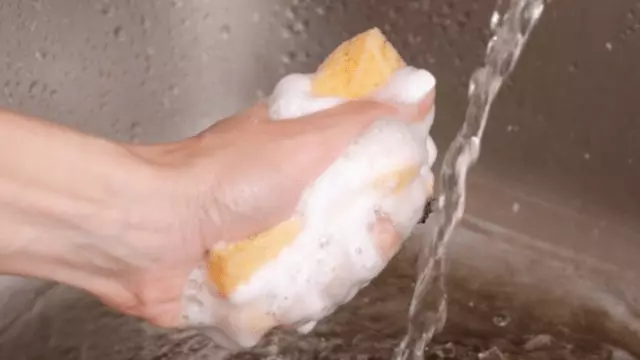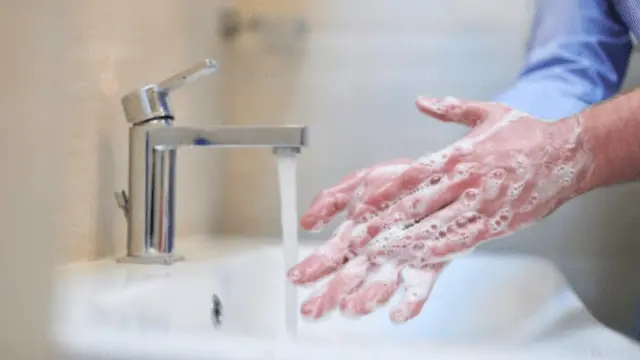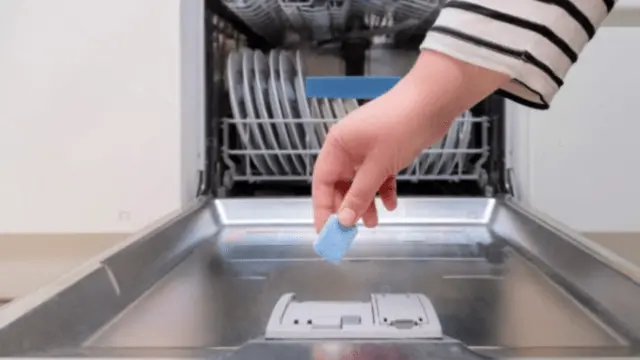Soap suds in the dishwasher is a frustrating issue for many homeowners. It occurs when there is an excessive buildup of soap bubbles during the dishwasher’s wash cycle.
While we usually associate soap suds with our washing machines or hand washing dishes, it may come as a surprise that they can also make a mess inside our dishwashers.
Excess soap suds can lead to a difficult cleaning performance. When the dishwasher is dipped with suds, it can struggle to effectively wash and rinse the dishes.
As a result it ends up in residues of food particles and detergent left behind on your plates and utensils.
This not only affects the purpose of using a dishwasher but also leaves you with the unenviable task of re-washing your dishes by hand.
You Must Fix This Issue of Soap Suds ASAP

Soap suds in the dishwasher can lead to more serious issues, such as leaks. The excess foam can cause overflow from the dishwasher’s door, leading to water spilling onto your kitchen floor.
This not only creates a mess but can cause a safety issue due to slippery surfaces. In some cases, the leakage might seep into the dishwasher’s electrical components. In this case, it is potentially causing damage that requires costly repairs.
Because, if you ignore this issue, soap suds can greatly affect the longevity of your dishwasher. The foamy residue can accumulate within the machine’s internal parts, including pumps, hoses, and filters.
Over time, this buildup can lead to clogs and reduced efficiency, potentially shortening the lifespan of your appliance.
The soap suds in the dishwasher may seem like a minor inconvenience, they can have huge consequences. It’s not only about the inconvenience of rewashing dishes. it’s about maintaining the functionality, safety, and longevity of your dishwasher.
Fixing this issue quickly is key to ensuring that your dishwasher continues to serve you well in the long run.
What is the Cause of Soap Suds?

Coming back to the root, what could be the potential cause behind this crap? Well, soap suds in the dishwasher can arise due to several key factors.
One primary reason is the use of incorrect detergent. When the wrong type of detergent is used, it can lead to excessive suds formation during the dishwasher cycle.
Another important factor is the excessive use of detergent. Pouring an excessive amount of detergent into the dishwasher can easily result in an overflow of suds. It causes them to spill out of the dishwasher and potentially create a mess.
Lastly, the hardness of water can play a role in the formation of soap suds. Soft water, which contains fewer minerals, tends to generate more suds when combined with detergent.
These factors, such as the use of the wrong detergent, excessive detergent, or the presence of soft water, can all contribute to the bug of soap suds in the dishwasher.
How to Stop Soap Suds in Dishwasher

Excess suds in your dishwasher can lead to poor performance and potential damage. So just follow this step-by-step guide to effectively remove excess suds and keep your dishwasher running smoothly.
Step 1: Pause the Dishwasher
If your dishwasher is currently running, pause the cycle. Open the dishwasher door and let it sit for a few minutes to allow the suds to settle.
Step 2: Remove Excess Water
Carefully use a sponge or a towel to soak up any excess water in the bottom of the dishwasher. This will help prevent overflow when you resume the cycle.
Step 3: Add Vinegar
In a bowl, mix a solution of equal parts water and white vinegar. For example, one cup of water and one cup of white vinegar. Vinegar helps break down the suds.
Step 4: Apply the Vinegar Solution
Slowly pour the vinegar solution into the bottom of the dishwasher. Be cautious not to overfill, as the dishwasher may not drain properly.
Step 5: Close the Dishwasher Door
Gently close the dishwasher door and resume the cycle. Let the vinegar solution mix with the water and suds.
Step 6: Pause and Wipe Down
After a few minutes, pause the dishwasher again. Open the door and wipe down the interior with a clean cloth or sponge. Pay attention to any suds still present.
Step 7: Repeat if Necessary
If the suds persist, repeat the process by adding more vinegar solution. It may take a couple of cycles to completely eliminate the excess suds.
Step 8: Run a Rinse Cycle
Once the suds are mostly gone, run a rinse cycle without any dishes. This helps to ensure that any remaining residue is washed away.
Step 9: Check for Residue
Inspect the dishwasher for any soap residue. If you notice any, wipe it away with a damp cloth.
Step 10: Final Check
Run a short regular cycle with a few dishes to ensure that the excess suds have been completely eliminated.
Can Proper Loading Techniques Is Enough to Solve the Problem?
Perhaps you’ve heard that perfect loading dishes can prevent soap suds in the dishwasher. Yeah, it really does and it could be an alternative to the previous method we mentioned. Let’s take a closer look at it:
Since, it’s important to leave enough space between the dishes. Overcrowding the dishwasher creates the flow of water and it can trap detergent in it. That’s what is leading to suds.
By arranging the dishes with ample space between them, you allow the water to circulate freely and rinse away the detergent.
It’s always better to position the dishes in a way that allows water to reach all surfaces. Place larger items such as plates, platters, and cutting boards along the sides and back of the dishwasher.
This arrangement ensures that water jets can reach the interior of these items and effectively clean them.
Smaller items like cups, glasses, and utensils should be loaded in the top rack. Make them facing downward, to allow water to flow through them and rinse away any detergent.
Most importantly while loading utensils, it’s beneficial to alternate their position. Place some handles up and others down to prevent them from nesting together.
Try to make sure that no items are blocking the dishwasher’s spray arms. These rotating arms distribute water throughout the dishwasher, ensuring thorough cleaning.
Check that no large dishes or utensils stops the spray arms, preventing them from reaching all areas.
Conclusion
The step-by-step guide we’ve shared in this article provides an approach to resolving excess suds efficiently.
By pausing the dishwasher, removing excess water, and introducing a vinegar solution, you initiate a process that breaks down and eliminates the suds effectively.
To keep your dishwasher running smoothly and ensure your dishes come out clean every time, follow these simple steps.
Make sure to use the right dishwasher detergent and measure it correctly. If you notice too many suds during a wash, don’t worry—it’s common. Just be persistent and repeat the steps until the excess suds are gone.
FAQ
Q: Why does my dishwasher leave soapy residue on dishes?
A: Using too much detergent or a low-quality detergent can lead to soapy residue. Adjust the amount and choose a high-quality detergent for better results.
Q: Why does my dishwasher keep foaming?
A: Excessive foaming may result from using regular dish soap instead of dishwasher detergent. Switch to the correct detergent to prevent foaming issues.
Q: How do you neutralize dishwasher soap?
A: To neutralize excessive soap, run a rinse cycle without any dishes or detergent. This helps clear out lingering soap from the dishwasher.
Q: What kills soap suds?
A: Vinegar or a small amount of cooking oil added to the dishwasher can help break down and eliminate soap suds, ensuring a suds-free wash.
